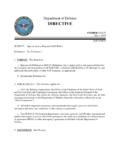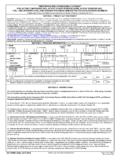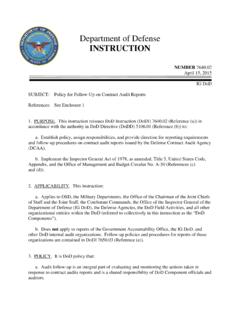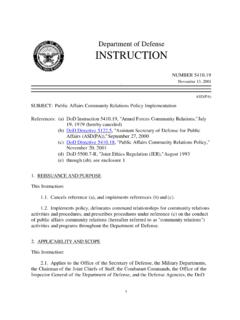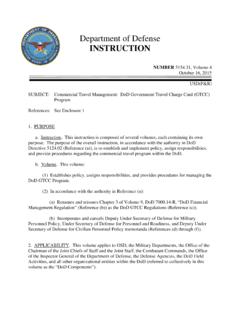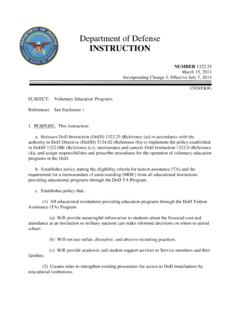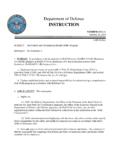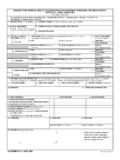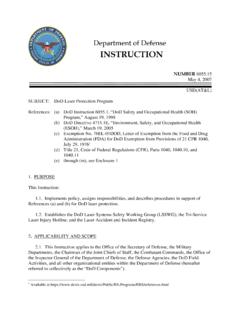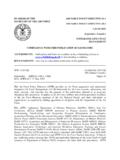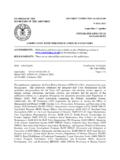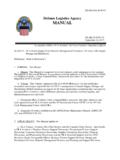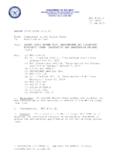Transcription of DoD Directive 4151.18, March 31, 2004
1 DODD March 31, 2004 This Directive applies to the Office of the Secretary of Defense, the Military Departments, the Chairman of the Joint Chiefs of Staff, the Combatant Commands, the Office of the Inspector General of the Department of Defense, the Defense Agencies, the DoD Field Activities, and all other organizational entities in the Department of Defense (hereafter referred to collectively as "the DoD Components"). 3. POLICY It is DoD policy that: Maintenance programs for DoD materiel shall be structured and managed to achieve inherent performance, safety and reliability levels of the materiel. Maintenance tasks restore safety and reliability to their inherent levels when deterioration has occurred. Maintenance programs are structured for meeting readiness and sustainability objectives (including mobilization and surge capabilities) of national defense strategic and contingency requirements.
2 In addition, maintenance programs shall: Employ maintenance concepts that optimize process technologies, organizational structures and operating concepts to deliver efficient and effective performance to the operating forces. Be clearly linked to strategic and contingency planning. Provide organic maintenance for inherently Governmental and core capability requirements in accordance with Section 2464 of title 10, United States Code (reference (e)). Non-core capability requirements shall be satisfied using competitive sourcing, as appropriate, and in accordance with Section 2462 of title 10, United States Code (reference (f)) and Section 2466 of title 10, United States Code (reference (g)), to lower costs and improve performance across the full spectrum of maintenance activities.
3 Be designed for minimizing the total life-cycle cost of ownership. The programs shall effectively address all maintenance requirements whether afloat, at a fixed base, deployed site, centralized repair activity, in storage, or en route. Their design shall minimize the footprint of maintenance capabilities employed in an area of operation. DODD , March 31,2004 .S. Adopt business practices and quality management processes to continuously improve maintenance operations and maintenance production, achieve cost savings and avoidance, and realize process cycle time reduction. Invest in the development of new technologies to improve the reliability, maintainability and supportability of DoD materiel, including the cost, schedule effectiveness, and quality of maintenance tasks andprocesses.
4 Employ the full spectrum of maintenance support structures available to sustain military materiel, including organic or unique military capabilities, performance-based logistics arrangements, commercial sector support, partnering, and competition, as applicable. The programs shall appropriately use corporate contracting techniques for depot maintenance of secondary items. Ensure access to support and support-related technical information is consistent with the planned support concept to cost effectively maintain fielded systems and foster competition for sources of support throughout the life of the fielded systems. Take steps to minimize and prevent Environmental, Safety, and Occupational Health hazards in maintenance activities. The use, generation, storage and disposal of hazardous materiel at maintenance locations shall be minimized.
5 Design of maintenance tasks and processes shall give consideration to environmental and human factors to allow for safe, efficient, and effective task accomplishment. Comply with periodic and as-required reporting requirements. Initial maintenance program management shall begin at acquisition program initiation. Maintenance processes shall be structured to provide information necessary for design improvement of DoD materiel when inherent performance or reliability levels prove inadequate. Initial maintenance programs shall: Be developed concurrently with materiel design, beginning with an analysis of failure modes and effects. The programs shall consist of applicable and effective tasks for addressing the failure modes and effects using reliability-centered analysis, and shall allocate tasks to appropriate levels of maintenance ( , field and depot) based on criteria derived from customer requirements and cost-effectiveness analysis.
6 Task development shall include: determination of initial compliance thresholds and task repetition intervals; and a plan for providing feedback to the design process if effective maintenance tasks cannot adequately address a failure mode or effect. DODD , March 31, 2004 Identify depot maintenance core capability requirements, as required by reference (e). Depot maintenance core capability requirements shall be identified as early as possible in the acquisition life cycle. The capabilities to support these depot maintenance core requirements shall be established not later than 4 years after Initial Operational Capability for DoD materiel directly supporting the Department's strategic and contingency plans. Exceptions to this requirement can be made for systems and equipment under special access programs, nuclear carriers, and commercial items.
7 As requirement for establishing core capability applies to public sector depot maintenance resources (including personnel, equipment, and facilities) maintained by the Department of Defense. Required core capabilities, and the depot maintenance workloads needed to sustain those capabilities, shall be calculated by the individual DoD Components in accordance with a methodology approved by the Under Secretary of Defense (Acquisition, Technology, and Logistics) (USD(AT&L)). Workloads required to sustain core capability requirements shall be the primary workloads assigned to DoD depots. Core capabilities and associated workloads shall be adjusted periodically, and reviewed formally on a biennial basis, for force structure changes, introduction of new weapon systems, and changes in battle doctrine to counter emerging threats.
8 All maintenance andrepair of weapon systems necessary for strategic and contingency plans need not be performed in public facilities; rather, the capability (in the form of skills, equipment and facilities) to perform maintenance and repair of these systems must be retained in those facilities. Incorporate sustainment procedures interfacing effectively with DoD logistics processes for DoD materiel that shall be maintained by the private sector. Minimize requirements for support equipment including test, measurement, and diagnostic equipment. When the use of support equipment may not be eliminated, standardize support equipment design for the broadest possible range of applications, consistent with maintenance concepts. Maintenance programs for military materiel shall utilize diagnostics, prognostics and health management techniques in embedded and off-equipment applications when feasible and cost-effective.
9 Maintenance programs shall provide the organic maintenance workforce with the range of technological tools necessary to enhance capabilities ( , interactive technical manuals, portable maintenance aids, access to technical information), properly equip the workforce and provide adequate technical and managerial training. Employ Serialized Item Management (SIM) techniques to effectively manage populations of select items throughout their life cycle. SIM programs shall focus on providing comprehensive and timely data for each identified item. DoD materiel shall be equipped with Automatic Identification Technology (MT) allowing for DODD , March 31, 2004 paperless identification, minimizing data entry requirements, and facilitating digital storage and retrieval of essential information including maintenance history.
10 SIM programs shall build on existing serial number traclung initiatives and leverage continuing progress in AlT. Throughout the life cycle of military materiel, maintenance programs shall be adjusted periodically to improve maintenance agility, increase operational availability, and reduce life-cycle total ownership costs. In addition: Maintenance engineering (the application of techniques, engineering skills, and effort organized to ensure the design and development of weapon systems and equipment provide adequately for effective and economical maintenance) shall be used for identifying the most cost-effective combination of maintenance capabilities provided via organic, contract, and inter-Service sources of repair. Commercial items should employ applicable commercial maintenance programs.
